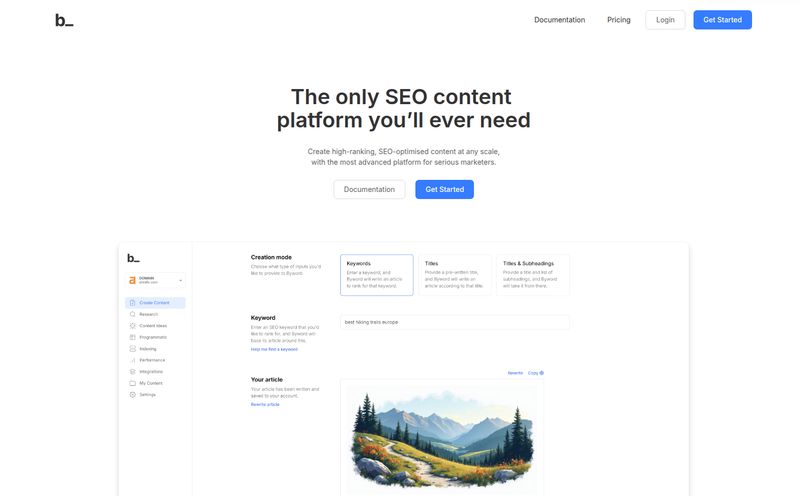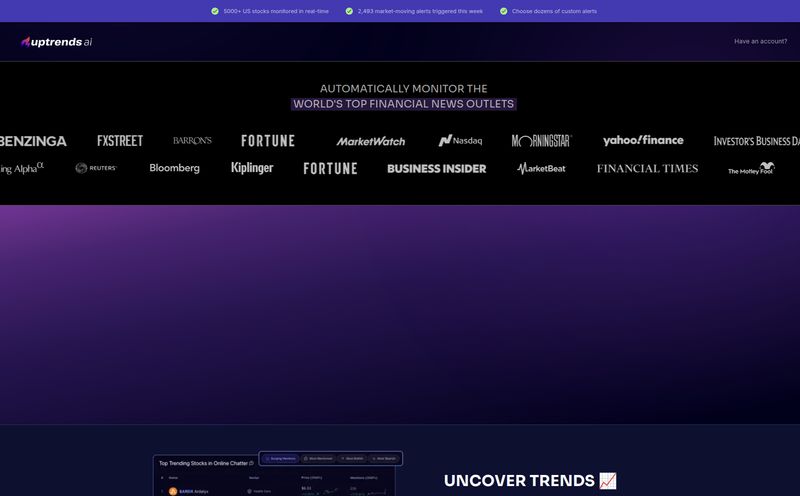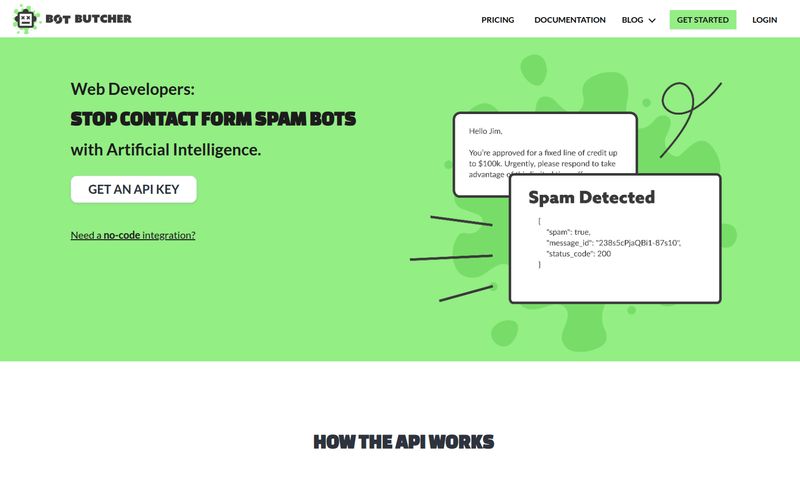When another “AI-powered” tool slides into my inbox, my first reaction is usually a deep, world-weary sigh. We're drowning in them, aren't we? Every other startup is bolting a GPT wrapper onto a spreadsheet and calling it a revolution. So, when I first heard about CrawlAi, I was skeptical. Another scraper? Another content generator? Yawn.
But then I looked closer. And what I found wasn't another blunt instrument trying to be an all-in-one solution. It felt... different. More focused. Almost like a specialized tool you’d find in a craftsman's workshop, not a multi-tool from a gas station. It’s designed to do a few things really well, specifically for folks like us who live and breathe web data but dont always have the budget for the big guns like Screaming Frog or the time for complex setups.
So, I decided to give it a spin. Is it perfect? Oh, heavens no. But is it interesting? Absolutely. Let’s get into what this thing is, what it does, and whether it’s worth the price of a fancy coffee.

Visit CrawlAi
First Off, What Is CrawlAi Anyway?
Let's clear something up. CrawlAi isn't a search engine. It’s not trying to replace Google or Perplexity. It’s a web scraping tool at its core. Think of it less like a librarian who finds books for you and more like a meticulous research assistant who goes to a specific page you point to, reads it, and hands you back a neat set of organized notes.
Its main job is to pull data from specific webpages and turn it into something you can actually use—structured data. You give it a URL (or a bunch of them), and it can summarize the content, pull out keywords, and even snag all the images for you. It’s built for surgical strikes, not carpet bombing. You maintain full control by focusing on a page-by-page analysis, which is a different philosophy from tools that just crawl an entire domain and dump a 500-page PDF on your desk.
The Features That Actually Matter
A feature list is just a list until you see how it applies to the daily grind. Here’s my take on CrawlAi’s core offerings and how they might actually save you a headache or two.
Multi-URL Crawling and Summarization
This is probably the headliner. You can feed CrawlAi a list of URLs and have it work its magic on all of them at once. Imagine you're doing competitor research. You can grab the top 10 ranking articles for your target keyword, plug them into CrawlAi, and get a quick summary of each one. In minutes, you have the gist of a dozen long-form posts without having to read 20,000 words. That’s a huge time-saver. It's great for spotting patterns, common arguments, and data points across the competitive landscape.
Keyword and SEO Content Generation
Okay, the phrase “SEO-friendly content creation” always sets off my alarm bells. Most AI writers produce generic, soul-less fluff. I see CrawlAi's content generator as more of a sophisticated outliner. It analyzes the content on the URLs you provide and can generate a blog post draft. I wouldn't copy-paste and publish this stuff. Ever. But as a way to generate a structured outline based on what's already ranking? That’s genuinely useful. It can help you build a solid framework that you can then flesh out with your own expertise, voice, and research. It's a starting block, not the whole race.
Niche Extraction Tools
CrawlAi also lets you do things like extract all the images from a page and get them listed in a clean JSON format. Is this a feature I'd use every day? Probably not. But for an e-commerce analyst wanting to quickly grab all product shots from a competitor’s category page, or a designer looking for inspiration, it’s a neat little trick to have up your sleeve.
The Good, The Bad, and The Beta
No tool is a silver bullet. I’ve been in this game long enough to know that every shiny new toy comes with its own set of quirks and limitations. CrawlAi is no exception, especially since it’s still in beta.
What I Genuinely Like
The control is the big one for me. By focusing on single pages, it doesn't get lost or overwhelmed. It does exactly what you tell it to. I also appreciate its honesty. It's a scraper and a summarizer, and it's not pretending to be a full-blown SEO suite. The multi-URL feature is a game-changer for quick analysis projects. It has a clear purpose, and for the most part, it sticks the landing.
Where It Stumbles
The single-page focus is a double-edged sword. This is not the tool for a comprehensive technical site audit. You can't just plug in a domain and expect a full report on broken links, schema, and site architecture. You’ll still need your Ahrefs or SEMrush for the heavy lifting.
Also, it's a beta product. That means you should expect some jank. Things might break, the servers might be slow at times, and features could change. And the company is upfront that the extracted data isn't 100% guaranteed to be accurate. My advice? Trust, but verify. Use its output as a guide, not as gospel. Always give it a once-over before basing a major strategic decision on it.
Let’s Talk Money: The CrawlAi Pricing Plan
This is where things get really interesting. CrawlAi has a plan called the “Coffee Plan,” and it’s priced at $5 per month. The messaging is a little confusing—I saw mentions of both “/month” and “one-time payment.” My guess is it’s a simple monthly subscription and the “one-time” language is either a typo or refers to some initial offer. For five bucks, you get access to all the core features: multi-URL crawling, summarization, and early access to new stuff.
| Plan Name | Price | Key Features |
|---|---|---|
| Coffee Plan | $5 /month | Summarize full-length articles, Multi-URL crawling, summarization and extraction, Early access to new features. Best for students and researchers. |
So, is it worth it? In my opinion, yes. For the cost of a single latte, you get a tool that can save you hours of manual research each month. It’s a no-brainer for freelance SEOs, students, or content marketers on a tight budget. You can find out more on their pricing page.
So, Who Is This Tool Actually For?
CrawlAi has carved out a nice little niche for itself. It's not for everyone, and that's okay.
This tool is perfect for:
- The Solo SEO or Freelancer: When you need to do quick-and-dirty competitive analysis without firing up a massive, expensive tool.
- The Content Marketer: For generating topic outlines, pulling stats from multiple sources, and understanding the core themes of top-ranking content.
- The Student or Academic Researcher: An absolute lifesaver for compiling and summarizing information from dozens of online sources for a literature review or research paper.
Who should probably skip it?
- The Enterprise SEO Team: If you need full-site technical audits, log file analysis, and deep backlink data, this isn't your solution. Stick to the enterprise-grade platforms.
- The Total Beginner: If you don't understand what web scraping is or why you'd want to extract structured data, the tool might not make much sense to you.
My Final Take on CrawlAi
I came in cynical, but I’m walking away pleasantly surprised. CrawlAi isn't going to revolutionize the SEO industry, and it's not going to replace the powerhouse tools we rely on for deep technical analysis. But it’s not trying to.
Instead, it's an affordable, focused, and genuinely useful utility. It’s the kind of tool that, once you have it, you’ll find all sorts of little uses for it. It smooths out some of the most tedious parts of our jobs—the manual data collection and content sifting. For five dollars a month, it's a powerful little assistant to have in your digital toolbox. I’m excited to see how it develops as it moves out of beta.
Frequently Asked Questions
- How is CrawlAi different from using ChatGPT with web browsing?
- ChatGPT gives you a conversational summary, which is great for getting a general idea. CrawlAi is built for structured data extraction. It pulls specific elements—like keywords, images, or summaries from multiple URLs at once—into an organized format you can actually work with, which is much more efficient for analysis.
- Can CrawlAi scrape an entire website at once?
- No, its strength lies in its page-by-page focus. It’s designed for analyzing a specific set of URLs rather than performing a full-domain crawl. For a full site audit, you'd need a tool like Screaming Frog.
- Is the data from CrawlAi 100% accurate?
- The developers state that accuracy is not guaranteed to be 100%. Like any scraping tool, it can sometimes misinterpret complex page layouts. It's always a good practice to double-check the critical data it provides.
- What do I get with the $5 'Coffee Plan'?
- The Coffee Plan at $5/month gives you access to the main features, including multi-URL crawling, content summarization, data extraction, and early access to new features as they are developed.
- Can I really generate a finished blog post with CrawlAi?
- I wouldn't recommend it. The AI-generated content is best used as a detailed starting point or a well-structured outline. It's a great way to beat the blank page, but it still needs a human touch, your unique insights, and proper fact-checking to become a quality piece of content.
Reference and Sources
- CrawlAi Pricing Information: https://www.examplecompany.com/pricing



